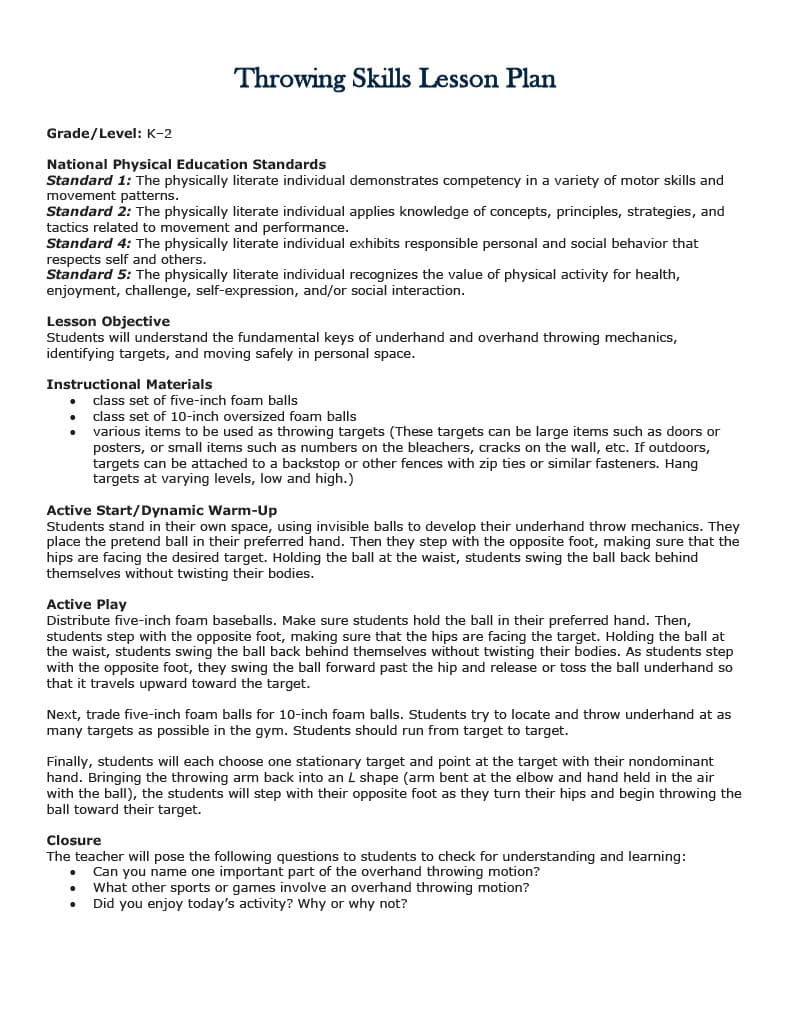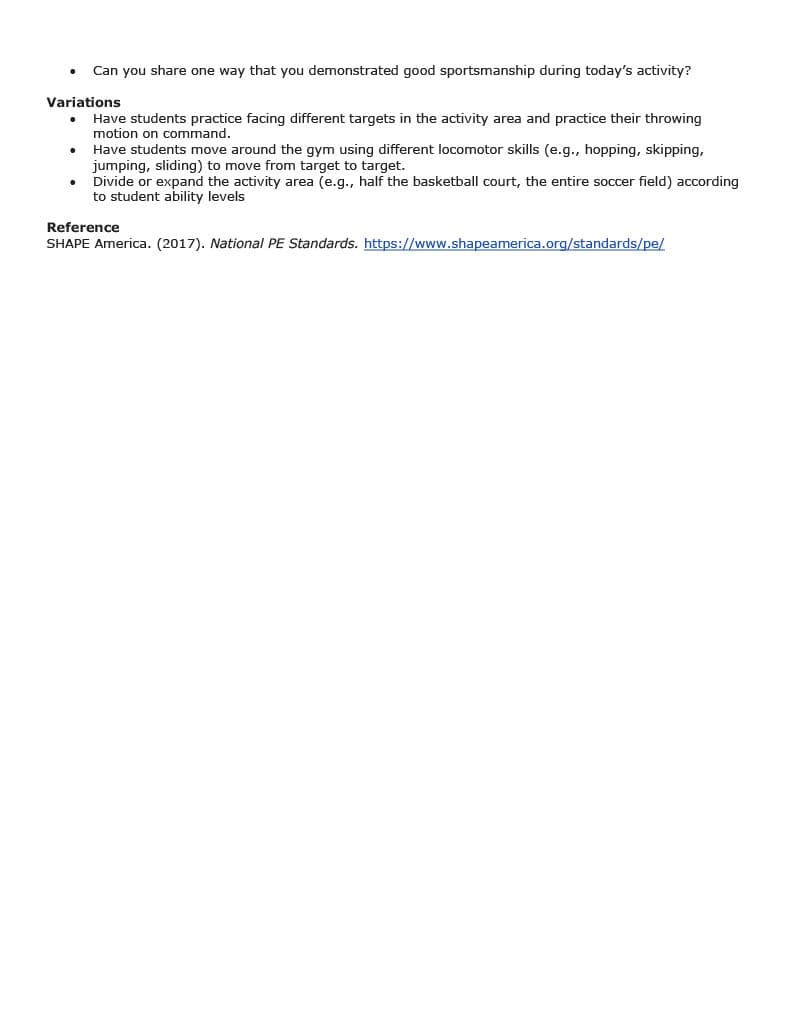Throwing Skills Lesson Plan Grade/Level: K-2 National Physical Education Standards Standard 1: The physically literate individual demonstrates competency in a variety of motor skills and movement patterns. Standard 2: The physically literate individual applies knowledge of concepts, principles, strategies, and tactics related to movement and performance. Standard 4: The physically literate individual exhibits responsible personal and social behavior that respects self and others. Standard 5: The physically literate individual recognizes the value of physical activity for health, enjoyment, challenge, self-expression, and/or social interaction. Lesson Objective Students will understand the fundamental keys of underhand and overhand throwing mechanics, identifying targets, and moving safely in personal space. Instructional Materials class set of five-inch foam balls class set of 10-inch oversized foam balls various items to be used as throwing targets (These targets can be large items such as doors or posters, or small items such as numbers on the bleachers, cracks on the wall, etc. If outdoors, targets can be attached to a backstop or other fences with zip ties or similar fasteners. Hang targets at varying levels, low and high.) Active Start/Dynamic Warm-Up Students stand in their own space, using invisible balls to develop their underhand throw mechanics. They place the pretend ball in their preferred hand. Then they step with the opposite foot, making sure that the hips are facing the desired target. Holding the ball at the waist, students swing the ball back behind themselves without twisting their bodies. Active Play Distribute five-inch foam baseballs. Make sure students hold the ball in their preferred hand. Then, students step with the opposite foot, making sure that the hips are facing the target. Holding the ball at the waist, students swing the ball back behind themselves without twisting their bodies. As students step with the opposite foot, they swing the ball forward past the hip and release or toss the ball underhand so that it travels upward toward the target. Next, trade five-inch foam balls for 10-inch foam balls. Students try to locate and throw underhand at as many targets as possible in the gym. Students should run from target to target. Finally, students will each choose one stationary target and point at the target with their nondominant hand. Bringing the throwing arm back into an L shape (arm bent at the elbow and hand held in the air with the ball), the students will step with their opposite foot as they turn their hips and begin throwing the ball toward their target. Closure The teacher will pose the following questions to students to check for understanding and learning: Can you name one important part of the overhand throwing motion? What other sports or games involve an overhand throwing motion? Did you enjoy today's activity? Why or why not? . Can you share one way that you demonstrated good sportsmanship during today's activity? Variations Have students practice facing different targets in the activity area and practice their throwing motion on command. . Have students move around the gym using different locomotor skills (e.g., hopping, skipping, jumping, sliding) to move from target to target. Divide or expand the activity area (e.g., half the basketball court, the entire soccer field) according to student ability levels Reference SHAPE America. (2017). National PE Standards. https://www.shapeamerica.org/standards/pe/
Throwing Skills Lesson Plan Grade/Level: K-2 National Physical Education Standards Standard 1: The physically literate individual demonstrates competency in a variety of motor skills and movement patterns. Standard 2: The physically literate individual applies knowledge of concepts, principles, strategies, and tactics related to movement and performance. Standard 4: The physically literate individual exhibits responsible personal and social behavior that respects self and others. Standard 5: The physically literate individual recognizes the value of physical activity for health, enjoyment, challenge, self-expression, and/or social interaction. Lesson Objective Students will understand the fundamental keys of underhand and overhand throwing mechanics, identifying targets, and moving safely in personal space. Instructional Materials class set of five-inch foam balls class set of 10-inch oversized foam balls various items to be used as throwing targets (These targets can be large items such as doors or posters, or small items such as numbers on the bleachers, cracks on the wall, etc. If outdoors, targets can be attached to a backstop or other fences with zip ties or similar fasteners. Hang targets at varying levels, low and high.) Active Start/Dynamic Warm-Up Students stand in their own space, using invisible balls to develop their underhand throw mechanics. They place the pretend ball in their preferred hand. Then they step with the opposite foot, making sure that the hips are facing the desired target. Holding the ball at the waist, students swing the ball back behind themselves without twisting their bodies. Active Play Distribute five-inch foam baseballs. Make sure students hold the ball in their preferred hand. Then, students step with the opposite foot, making sure that the hips are facing the target. Holding the ball at the waist, students swing the ball back behind themselves without twisting their bodies. As students step with the opposite foot, they swing the ball forward past the hip and release or toss the ball underhand so that it travels upward toward the target. Next, trade five-inch foam balls for 10-inch foam balls. Students try to locate and throw underhand at as many targets as possible in the gym. Students should run from target to target. Finally, students will each choose one stationary target and point at the target with their nondominant hand. Bringing the throwing arm back into an L shape (arm bent at the elbow and hand held in the air with the ball), the students will step with their opposite foot as they turn their hips and begin throwing the ball toward their target. Closure The teacher will pose the following questions to students to check for understanding and learning: Can you name one important part of the overhand throwing motion? What other sports or games involve an overhand throwing motion? Did you enjoy today's activity? Why or why not? . Can you share one way that you demonstrated good sportsmanship during today's activity? Variations Have students practice facing different targets in the activity area and practice their throwing motion on command. . Have students move around the gym using different locomotor skills (e.g., hopping, skipping, jumping, sliding) to move from target to target. Divide or expand the activity area (e.g., half the basketball court, the entire soccer field) according to student ability levels Reference SHAPE America. (2017). National PE Standards. https://www.shapeamerica.org/standards/pe/
Related questions
Question
Evaluate the following aspects of the lesson plan (attached) effectiveness of the instructional plan, including the following:
• anticipatory set
• presentation procedures for new information or modeling (or both)
• guided practice
• independent student practice
• culminating or closing procedure or activity

Transcribed Image Text:Throwing Skills Lesson Plan
Grade/Level: K-2
National Physical Education Standards
Standard 1: The physically literate individual demonstrates competency in a variety of motor skills and
movement patterns.
Standard 2: The physically literate individual applies knowledge of concepts, principles, strategies, and
tactics related to movement and performance.
Standard 4: The physically literate individual exhibits responsible personal and social behavior that
respects self and others.
Standard 5: The physically literate individual recognizes the value of physical activity for health,
enjoyment, challenge, self-expression, and/or social interaction.
Lesson Objective
Students will understand the fundamental keys of underhand and overhand throwing mechanics,
identifying targets, and moving safely in personal space.
Instructional Materials
class set of five-inch foam balls
class set of 10-inch oversized foam balls
various items to be used as throwing targets (These targets can be large items such as doors or
posters, or small items such as numbers on the bleachers, cracks on the wall, etc. If outdoors,
targets can be attached to a backstop or other fences with zip ties or similar fasteners. Hang
targets at varying levels, low and high.)
Active Start/Dynamic Warm-Up
Students stand in their own space, using invisible balls to develop their underhand throw mechanics. They
place the pretend ball in their preferred hand. Then they step with the opposite foot, making sure that the
hips are facing the desired target. Holding the ball at the waist, students swing the ball back behind
themselves without twisting their bodies.
Active Play
Distribute five-inch foam baseballs. Make sure students hold the ball in their preferred hand. Then,
students step with the opposite foot, making sure that the hips are facing the target. Holding the ball at
the waist, students swing the ball back behind themselves without twisting their bodies. As students step
with the opposite foot, they swing the ball forward past the hip and release or toss the ball underhand so
that it travels upward toward the target.
Next, trade five-inch foam balls for 10-inch foam balls. Students try to locate and throw underhand at as
many targets as possible in the gym. Students should run from target to target.
Finally, students will each choose one stationary target and point at the target with their nondominant
hand. Bringing the throwing arm back into an L shape (arm bent at the elbow and hand held in the air
with the ball), the students will step with their opposite foot as they turn their hips and begin throwing the
ball toward their target.
Closure
The teacher will pose the following questions to students to check for understanding and learning:
Can you name one important part of the overhand throwing motion?
What other sports or games involve an overhand throwing motion?
Did you enjoy today's activity? Why or why not?

Transcribed Image Text:.
Can you share one way that you demonstrated good sportsmanship during today's activity?
Variations
Have students practice facing different targets in the activity area and practice their throwing
motion on command.
.
Have students move around the gym using different locomotor skills (e.g., hopping, skipping,
jumping, sliding) to move from target to target.
Divide or expand the activity area (e.g., half the basketball court, the entire soccer field) according
to student ability levels
Reference
SHAPE America. (2017). National PE Standards. https://www.shapeamerica.org/standards/pe/
AI-Generated Solution
Unlock instant AI solutions
Tap the button
to generate a solution